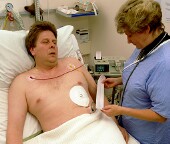- Understanding the Connection Between Anxiety and Depression
- How Daily Prunes Can Influence Cholesterol and Inflammation
- When to Take B12 for Better Absorption and Energy
- Epsom Salts: Health Benefits and Uses
- See What Saffron Can Do for Sleep and Heart Health
- 6 Common Mistakes to Avoid Before Your Physical
- Can Sweating Really Help You Beat a Cold?
- Strengthening Your Relationship: Practical Strategies
- Skip Storing This Everyday Product in the Fridge Door
- Green Tea + B3 Pairing May Boost Brain Health
Newer Blood Thinner Beats Heparin for Certain Heart Attacks


A blood thinner already used to treat dangerous blood clots in the limbs and lungs appears to be safer in treating certain heart attacks than the more powerful blood thinner that’s traditionally used, a new Swedish study has found.
Patients who received fondaparinux to treat a specific type of heart attack called non-ST-segment elevation myocardial infarction (NSTEMI) had a lower risk of major bleeding and death compared to patients who received heparin. Heparin is the blood thinner commonly used by doctors in heart attack cases, according to the study published in the Feb. 17 issue of the Journal of the American Medical Association.
These findings, drawn from a large Swedish health records database, confirm the results of a 2006 clinical trial that showed that fondaparinux could be used to safely and effectively treat these types of heart attacks, said lead author Dr. Karolina Szummer of the Karolinska Institute in Stockholm.
“For the average person, this is good news,” Szummer said, noting that these results are based on the general use of fondaparinux to treat heart attacks in Sweden in a “real world” setting, as opposed to a clinical trial in which patients were randomly chosen to receive the drug.
When Swedish doctors in the regular course of treatment chose to use fondaparinux to treat a heart attack, “the results persisted with improved survival and fewer bleeding events,” she said.
Fondaparinux already has been approved by the U.S. Food and Drug Administration for use in treating blood clots deep in the veins of the legs (deep vein thrombosis) and in the lungs (pulmonary embolism), said Dr. Mark Creager, president-elect of the American Heart Association.
Therefore, U.S. doctors can choose fondaparinux as an “off-label” drug for people suffering a heart attack, added Creager, who is director of the vascular center at Brigham and Women’s Hospital, and a professor at Harvard Medical School in Boston.
The FDA approved fondaparinux (Arixtra) in 2001, and a generic version of the drug became available in the United States in 2011, according to the agency’s records.
“Based on the earlier clinical trial and this study, it would be reasonable to consider using fondaparinux as an alternative to heparin to reduce the risk of bleeding and death in patients with this type of heart attack,” Creager said.
Szummer pointed out that European and American cardiology guidelines already recommend fondaparinux for treating heart attacks, even though the FDA has not approved it for that use.
For the new study, Szummer and her colleagues analyzed the medical records of more than 40,000 Swedish patients who had heart attacks classified as NSTEMIs between Sept. 2006 and June 2010.
Heart attacks occur when a blood clot prevents the flow of oxygen-rich blood to the heart. If blood flow isn’t restored quickly, the heart muscle begins to die.
An NSTEMI involves a partial or temporary blockage of the blood vessel leading to the heart, rather than a full blockage. About two-thirds of heart attacks in the United States are NSTEMIs, said Dr. Richard Kovacs, chair of the American College of Cardiology Anticoagulation Initiative and a cardiologist with Indiana University Health in Indianapolis.
Doctors use blood thinners to break up these blood clots. But, the drugs can cause dangerous bleeding that increases risk of death in heart attack patients, the authors noted in background information.
In this study, about 36 percent of Swedish patients received fondaparinux and 64 percent received heparin, the study authors reported.
The investigators found that fewer severe in-hospital bleeding events occurred in patients treated with fondaparinux — 1.1 percent compared with 1.8 percent for patients given heparin.
The fondaparinux patients also died less often during treatment in the hospital — 2.7 percent of all cases compared with 4 percent for the heparin group.
The differences in major bleeding events and death between the two treatments held steady at 30-day and six-month follow-ups, the findings showed.
Fondaparinux and heparin were about the same in terms of effectiveness. The rate of recurrent heart attack in the fondaparinux group was 9 percent versus 9.5 percent in the heparin group at 30 days, and just over 14 percent versus nearly 16 percent at six months. The rate of stroke was low in both groups, according to the study.
U.S. cardiology guidelines allow the use of fondaparinux but rate the evidence behind the drug as a B, “which means it’s a little less strong than other anticoagulants recommended for heart attacks,” Kovacs said.
These results could lead the task force that sets heart attack treatment guidelines to reconsider fondaparinux, Kovacs said.
“I think doctors will consider this in their treatment options, but until it finds its way into our guideline the way it has done in Europe, it probably won’t be a sea change,” Kovacs said.
However, another issue might hamper the widespread use of fondaparinux in America.
About two-thirds of NSTEMI patients in the United States are treated using cardiac catheterization, and when that technique is used doctors have to add an extra anticoagulant if they are already using fondaparinux, Kovacs said.
“That might influence decisions here compared to Europe,” where catheterization is less frequently used, he said.
More information
For more on heart attacks, visit the U.S. National Institutes of Health.
Source: HealthDay
Copyright © 2026 HealthDay. All rights reserved.










